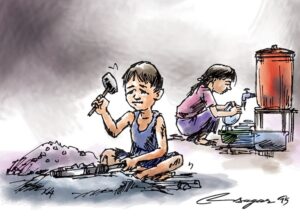Child Labour: A Veiled Barrier
to Inclusive Progress
(Relevant for General Studies Prelims and Mains)
 The insidious effects of the Covid-19 pandemic have sent shockwaves across the globe, revealing the cracks within critical sectors like healthcare, education, economy, and employment. India, amongst the hardest hit, discloses a staggering 531,843 reported deaths to WHO. But the marginalized sections, especially women and children, are the most severely impacted. In an already precarious economic environment, numerous households teeter on the brink of poverty. Such dire conditions have further deepened social inequalities, leaving women and children vulnerable to exploitation, violence, and insecurity.
The insidious effects of the Covid-19 pandemic have sent shockwaves across the globe, revealing the cracks within critical sectors like healthcare, education, economy, and employment. India, amongst the hardest hit, discloses a staggering 531,843 reported deaths to WHO. But the marginalized sections, especially women and children, are the most severely impacted. In an already precarious economic environment, numerous households teeter on the brink of poverty. Such dire conditions have further deepened social inequalities, leaving women and children vulnerable to exploitation, violence, and insecurity.
According to a 2022 joint report by UNICEF and the International Labour Organization (ILO), child labour has seen a sharp spike globally due to Covid-19. It’s estimated that child laborers will increase by a daunting 8.9 million by the end of 2022. The destabilization of global supply chains, as revealed by the US Department of Labor, has further amplified unemployment rates, leading to a distressing rise in poverty levels.
The pandemic has not only wreaked widespread destruction but also highlighted the entrenched inequalities and vulnerabilities within societies. Urgent and concerted efforts are required to tackle these issues and extend support and protection to the most vulnerable individuals in our communities.
Data: A Snapshot of the Crisis
India’s child labour crisis is deeply distressing, evidenced by the 2011 Census, which reported a shocking 10.1 million child laborers. The National Crime Records Bureau Report of 2022 provides further evidence, with 982 cases registered under the Child Labour (Prohibition and Regulation) Act of 1986 in 2021 alone. The states of Telangana and Assam have emerged with the highest number of registered cases, illustrating the extent of this issue.
COVID-19 has worsened the plight of migrant children. A study by Aide et Action in India reveals a grim reality: a twofold increase in children joining their working parents in the brick-making industry post the initial wave of the pandemic. A research by the Campaign Against Child Labour (CACL) underlines a concerning shift, with the proportion of working children soaring from 28.2% to 79.6% among the 818 surveyed children. This concerning trend can largely be ascribed to the COVID-19 pandemic and the resultant closure of schools.
The harsh impact of COVID-19 is not confined to India. A recent report by the International Labour Organization (ILO) and UNICEF paints a dire global picture: the number of children engaged in child labour has surged to an alarming 160 million worldwide, with millions more at risk due to the pandemic’s ramifications.
Within India, Uttar Pradesh, Bihar, Rajasthan, Madhya Pradesh, and Maharashtra stand as the major contributors to the child labour crisis, highlighting the need to address this grave issue at both regional and national levels.
Prominent Causes of Child Labour in India
• Poverty: Poverty shackles countless families, unable to meet even basic necessities, pushing them to make a heart-wrenching decision. Instead of providing their children with an education, they are forced to send them to work. The harsh reality of poverty also coerces some children into a life of bonded labor or compels them to migrate to unfamiliar territories in search of meager employment opportunities.
• Social Norms: Deep-rooted traditions in certain communities and families mandate child labor in specific occupations like agriculture, carpet weaving, or domestic service. These societal norms perpetuate the belief that education holds little importance, particularly for girls who are denied their rightful access to learning.
• Lack of Decent Work Opportunities for Adults and Adolescents: The pervasive unemployment crisis and dismal wages have led to a dearth of honorable work options for adults and adolescents. With dreams of a dignified livelihood shattered, many resort to informal, exploitative, and hazardous labor, thrusting their own children into the vicious cycle of labour.
• Poor School Infrastructure: The education landscape in India is marked by woefully inadequate school infrastructure. Insufficient facilities, a dearth of qualified teachers, and substandard education plague numerous educational institutions across the country. Moreover, the burden of exorbitant fees and additional expenses dissuades impoverished families from enrolling their children and drives numerous youngsters into premature withdrawal from education.
• Emergencies: Natural disasters, conflicts, or pandemics can unravel the fabric of society, leaving vulnerable children exposed to unparalleled hardships. The consequences of such emergencies are devastating, with children stripped of their parents, homes, and access to fundamental services. Left to fend for themselves, they face the stark choice of engaging in arduous labor simply to survive or falling prey to human traffickers and other exploiters.
• Plunge in Living Standards: The relentless onslaught of the pandemic has triggered a storm of economic insecurity, rampant unemployment, abject poverty, and gnawing hunger. In this harrowing landscape, children are left with no choice but to toil relentlessly for their very survival, forsaking their right to a childhood.
• Loss of Guardianship: The pandemic has mercilessly snatched away the lives of many, leaving behind a trail of orphaned children. Bereft of parental care and protection, these innocent souls are thrust into the dark abyss of child labor, their dreams shattered and their futures marred by unimaginable hardships.
• Deteriorating Employment Opportunities: The devastating impact of the pandemic reverberates far and wide, crippling once-thriving supply chains, trades, and foreign investments. The resulting vacuum in labor demand and income opportunities for adults has cast a sinister shadow upon the lives of children, rendering them all the more vulnerable to exploitation and coercion.
• Rise in Informality: The insidious grip of the pandemic has fueled an alarming surge in the ranks of the informal workforce. Trapped in this grim reality, children find themselves ensnared in labor within the shadowy realms of informal sectors, such as agriculture, domestic labor, vending, mining, and construction.
• Migration: The relentless waves of economic turmoil unleashed by the pandemic have triggered a mass exodus, both within national borders and across international boundaries. In this chaotic backdrop, migrant children bear the brunt of vulnerability as they become easy prey for exploitation and forced labor.
• Temporary School Closures: The harshest blow dealt by the pandemic has fallen upon education, shrouding millions of children in darkness. The swift closure of schools, coupled with the staggering inequalities that hinder access to online learning, thrusts vulnerable children into a perilous abyss. With their education disrupted, these children face heightened risks of dropping out, succumbing to early marriages, enduring teenage pregnancies, and being ensnared in child labor.
Socio-Economic Impact of Child Labour
• Eroded Human Capital Accumulation: Child labour erodes the foundation of children’s potential, impeding their ability to accumulate crucial skills and knowledge. This practice shackles their productivity and hampers their prospects of attaining sustainable incomes.
• Perpetuation of Poverty and Enduring Child Labor: The grip of child labor casts a dark shadow over the wages of unskilled labor, perpetuating a vicious cycle of poverty. The low wages offered for such work contribute to the entrapment of generations in the clutches of poverty and child labor.
• Impaired Technological Progress and Stifled Economic Growth: The grip of child labor suffocates progress and innovation, impeding technological advancement and long-term economic growth. The exploitation of children stifles potential breakthroughs and hampers socio-economic development.
• Deprivation of Rights and Diminished Opportunities: Child labor robs children of their inherent rights to education, health, protection, and active participation in society. This practice curtails these fundamental rights, inflicting a grave injustice upon the innocent and restricting their social mobility.
• Undermined Social Development and Fractured Cohesion: Child labor undermines the foundations of social development and cohesion within a nation. This practice erodes the bonds that hold communities together, imperiling stability and jeopardizing democracy.
• Devastating Health Impacts: Child labor exposes children to a litany of perils, including hazardous work environments, physical injuries, grave illnesses, and acts of abuse and exploitation. These conditions ravage their physical and mental well-being, affecting their mortality rates, life expectancy, and leaving a mark of suffering on their tender souls.
What Should Be Done
• The government must enact and revise legislation that stringently prohibits and regulates child labor, aligning with rigorous international standards. This decisive action is essential to safeguard the rights and well-being of innocent children.
• The government bears the responsibility of ensuring the robust implementation and enforcement of these laws. This necessitates the allocation of ample resources, strengthening institutional capacity, fostering robust coordination mechanisms, fortifying data collection and monitoring systems, demanding unwavering accountability, and igniting a steadfast political will.
• To instill fear in those who violate these laws, penalties must be severe and consistently enforced. This firm stance serves as a stern deterrent, sending an unequivocal message that child labor will not be tolerated, and those who exploit children shall face the full force of justice.
Best Sociology Optional Teacher, Best Sociology Optional Coaching, Sociology Optional Syllabus, Child Labour, COVID-19, India

